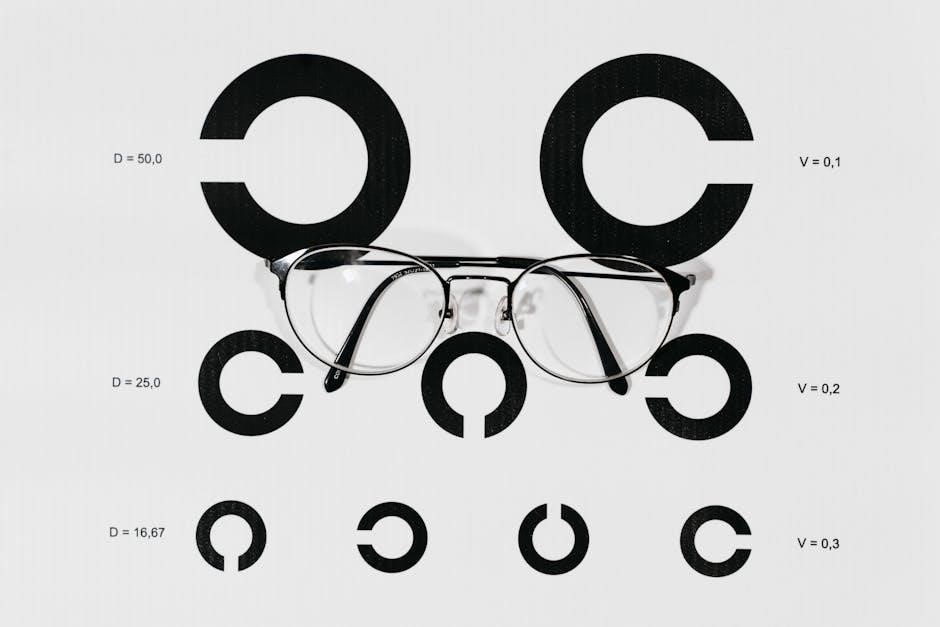Sight reading piano PDFs provide essential tools for pianists to improve their ability to play unfamiliar music confidently. These resources offer graded exercises‚ tips‚ and methods to enhance skills‚ catering to all levels from beginners to advanced players. They often include structured lessons‚ rhythmic drills‚ and practical advice to help musicians transition smoothly from practice to performance. By leveraging these comprehensive guides‚ pianists can refine their sight-reading abilities and expand their musical repertoire with ease.
What is Sight Reading in Piano?
Sight reading in piano is the ability to play unfamiliar sheet music accurately and expressively without prior practice. It involves immediately interpreting musical notation‚ rhythms‚ and dynamics while performing. This skill requires strong note recognition‚ hand-eye coordination‚ and mental focus. Sight reading is fundamental for pianists‚ enabling them to explore new repertoire‚ collaborate with others‚ and perform confidently in unexpected situations. It also enhances overall musicianship by fostering quick decision-making and adaptability. Regular practice with sight reading exercises and etudes helps build this essential skill‚ making it a cornerstone of piano education and artistic development.
Why Sight Reading is Essential for Pianists
Sight reading is a vital skill for pianists as it enhances musical versatility and adaptability. It allows musicians to explore new repertoire without extensive preparation‚ fostering spontaneity and creativity. Strong sight-reading abilities reduce performance anxiety by building confidence in playing unfamiliar music. This skill is crucial for accompanying others‚ improvising‚ and excelling in auditions or competitions; Additionally‚ sight reading improves overall musicianship by refining note recognition‚ rhythmic accuracy‚ and expressive interpretation. Regular practice strengthens these abilities‚ enabling pianists to approach any musical situation with ease and poise. Ultimately‚ sight reading is indispensable for both professional growth and the joy of discovering new music.
Overview of Sight Reading PDF Resources
Sight reading piano PDF resources offer a wide range of exercises and methods tailored to different skill levels. From beginner-friendly guides like Piano Sight Reading Exercises for Beginners to advanced tools such as Benedict’s Sight Reading for the Classic Piano‚ these resources provide structured lessons. Many PDFs‚ such as the Piano Safari Sight Reading & Rhythm Cards‚ incorporate rhythmic drills and interactive elements to enhance learning. Additionally‚ institutions like Trinity College London and ABRSM provide specimen sight-reading tests‚ offering real exam scenarios for practice. These resources often include graded exercises‚ tips for improvement‚ and practical advice‚ making them indispensable for pianists aiming to refine their sight-reading skills and expand their musical confidence.

Benefits of Sight Reading for Pianists
Sight reading enhances musicality‚ improves note accuracy‚ and boosts performance confidence. It allows pianists to play unfamiliar music fluently‚ expanding their repertoire and artistic expression effortlessly.
Improved Musicality and Expression
Sight reading significantly enhances a pianist’s ability to convey emotion and nuance in their playing. By focusing on interpreting dynamics‚ phrasing‚ and articulation instantly‚ pianists develop a deeper connection to the music. Regular practice with sight-reading PDFs helps internalize these musical elements‚ allowing for more expressive performances. Players learn to balance technical accuracy with artistic interpretation‚ creating richer‚ more engaging renditions of pieces. This skill fosters a more spontaneous and intuitive approach to music‚ enabling pianists to communicate the composer’s intent effectively. Over time‚ sight reading becomes a tool for unlocking the full emotional potential of any composition‚ making it an indispensable skill for every aspiring musician.
Enhanced Note Recognition and Accuracy
Sight reading piano PDFs are designed to sharpen a pianist’s ability to recognize and interpret musical notation swiftly and precisely. Regular practice with these resources trains the eyes and mind to process complex patterns‚ intervals‚ and rhythms accurately. By engaging with a variety of exercises‚ pianists develop the skill to identify notes‚ key signatures‚ and accidentals instantly‚ reducing errors during performance. Tools like Piano Sight Reading Exercises for Beginners and Benedict’s Sight Reading for the Classic Piano provide structured drills to refine this ability. Improved note recognition builds confidence and ensures that pianists can tackle unfamiliar scores with clarity and precision‚ making sight reading a cornerstone of their musical development.
Boosted Confidence in Performance
Regular practice with sight reading piano PDFs significantly enhances a pianist’s confidence during performances. By mastering unfamiliar scores‚ musicians develop the assurance to play without hesitation‚ even in high-pressure situations. These resources‚ such as Piano Sight Reading Exercises for Beginners and Benedict’s Sight Reading for the Classic Piano‚ provide structured exercises that gradually build proficiency. As pianists improve their ability to interpret and execute new music accurately‚ they feel more secure in their skills‚ leading to more expressive and assured performances. This confidence boost not only elevates their overall musicianship but also allows them to approach new challenges with greater ease and poise.

Methods and Techniques for Sight Reading
Effective sight reading involves breaking music into manageable sections‚ practicing rhythmic accuracy‚ and developing expressive playing. These techniques enhance fluency and overall performance quality.
Breaking Down the Music into Sections
Breaking down music into sections is a fundamental technique for effective sight reading. By dividing a piece into smaller‚ manageable parts‚ pianists can focus on one segment at a time‚ reducing overwhelm and improving accuracy. Start with short phrases or measures‚ gradually increasing the length as confidence grows. Identify repeating patterns or motifs within the sections‚ as these can simplify the learning process. Practicing hands separately before combining them helps build coordination and ensures a smoother performance; This method fosters familiarity with the structure and enhances overall musical understanding‚ making sight reading more approachable and enjoyable.
Practicing Rhythmic Accuracy
Practicing rhythmic accuracy is vital for strong sight-reading skills. Start by playing with a metronome to develop a steady tempo and ensure precise timing. Focus on complex rhythms by breaking them into simpler subdivisions‚ such as counting 16th notes within a beat. Emphasize playing note values accurately‚ paying attention to rests and syncopation. Sight-read passages at a slower tempo initially‚ then gradually increase speed as confidence builds. Regularly practicing rhythmic exercises from sight-reading PDFs helps refine your internal pulse and coordination. Over time‚ this consistency will enhance your ability to tackle unfamiliar music with precision and confidence.

Developing Expressive Playing
Developing expressive playing while sight-reading requires a balance between technical accuracy and musicality. Pay attention to dynamics‚ articulation‚ and phrasing even when encountering new pieces. Use sight-reading PDFs that include markings for crescendos‚ decrescendos‚ and tempo changes to guide your interpretation. Practice playing with varying touch‚ from delicate pianissimo to powerful fortissimo‚ to convey emotion. Focus on legato and staccato articulations to add character to your performance. Additionally‚ experiment with rubato and phrasing to breathe life into the music. By integrating these expressive elements during sight-reading practice‚ you can refine your ability to convey the composer’s intent authentically and connect with your audience on a deeper level.

Best Sight Reading PDF Resources
Piano Sight Reading Exercises for Beginners‚ Piano Safari Sight Reading Cards‚ and Benedict’s Sight Reading for the Classic Piano are top resources offering structured exercises and tips for improvement.
Piano Sight Reading Exercises for Beginners
Piano Sight Reading Exercises for Beginners offers a comprehensive guide for those starting their sight-reading journey. This resource includes 19 structured exercises designed to help pianists build confidence and accuracy. Each exercise provides clear musical notation and detailed instructions‚ ensuring a smooth learning process. The exercises focus on foundational skills such as note recognition‚ rhythm‚ and hand coordination. Beginners can start with simpler pieces and gradually progress to more complex ones‚ developing their ability to interpret sheet music effectively. Regular practice with these exercises helps improve sight-reading fluency and prepares pianists for more advanced repertoire. Downloading this PDF is an excellent way to establish a strong sight-reading foundation.
Piano Safari Sight Reading & Rhythm Cards
The Piano Safari Sight Reading & Rhythm Cards are a valuable tool for improving sight-reading and rhythmic accuracy. These cards are divided into five color-coded levels‚ corresponding to the five units in Piano Safari Repertoire Book 1. Each level gradually increases in difficulty‚ ensuring a smooth progression for learners. The cards focus on rhythm‚ timing‚ and note recognition‚ helping pianists develop a strong foundation. They are particularly effective for children‚ as they make practice engaging and fun. By incorporating these cards into daily routines‚ pianists can enhance their ability to play unfamiliar music with confidence and precision. This resource is ideal for both beginners and advanced players seeking to refine their skills.
Benedict’s Sight Reading for the Classic Piano
Benedict’s Sight Reading for the Classic Piano is a comprehensive guide designed to enhance sight-reading skills for pianists. This resource offers a wide range of exercises and pieces tailored to help musicians develop fluency and accuracy. It is particularly suited for intermediate to advanced players‚ providing challenging yet manageable material to refine technique. The PDF includes detailed instructions and progressive exercises that focus on dynamics‚ articulation‚ and phrasing. By practicing these pieces‚ pianists can improve their ability to interpret complex classical music with confidence. Benedict’s approach emphasizes expressive playing‚ ensuring that sight-reading becomes not just a technical skill but also an artistic expression. This resource is a valuable tool for pianists aiming to master classical repertoire and expand their musical understanding.
Trinity College London Sight Reading Method
The Trinity College London Sight Reading Method is a structured approach designed to help pianists master sight-reading skills progressively. This method is tailored for pianists of all levels‚ offering a clear and systematic way to improve their ability to read and interpret music accurately. The resource provides a wide range of exercises and pieces‚ focusing on rhythm‚ dynamics‚ and articulation. It is particularly beneficial for students preparing for Trinity College London examinations‚ as it aligns with the syllabus requirements. The method emphasizes expressive playing‚ ensuring that sight-reading becomes a natural part of performance. With its comprehensive and graded approach‚ this PDF is an invaluable tool for pianists seeking to enhance their sight-reading abilities and musical understanding.

ABRSM Specimen Sight Reading Tests
The ABRSM Specimen Sight Reading Tests are a collection of graded piano exercises designed to help pianists improve their sight-reading skills. These tests are part of the ABRSM graded piano exams and are available in PDF format for easy access. Each grade-specific test includes pieces that challenge pianists to read and play unfamiliar music accurately and expressively. The exercises cover a variety of styles and genres‚ ensuring a well-rounded approach to sight-reading. The tests focus on key areas such as rhythm‚ dynamics‚ and articulation‚ helping pianists build confidence and accuracy. By practicing these specimen tests‚ pianists can refine their skills and prepare for formal assessments or simply enhance their overall musicianship. These resources are invaluable for pianists seeking to master sight-reading at any level.

Practice Tips for Effective Sight Reading
Consistent practice‚ using a metronome‚ and focusing on dynamics and articulation are key. Start with slower tempos and gradually increase speed‚ ensuring accuracy and musicality are maintained throughout.
Daily Sight Reading Routine
A well-structured daily sight reading routine is crucial for consistent improvement. Begin with 10-15 minutes of warm-ups to loosen fingers and focus the mind. Select a piece at your current level and play it without stopping‚ even if mistakes occur. Focus on rhythm‚ dynamics‚ and articulation. Use a metronome to improve timing accuracy. After the first run-through‚ identify challenging sections and practice them slowly. Incorporate exercises from sight reading PDFs‚ such as scales or arpeggios‚ to build familiarity with different keys. Conclude by reviewing a previously practiced piece to reinforce learning. Maintain a journal to track progress and set weekly goals. Consistency is key to mastering sight reading effectively.
Practicing with Metronome
Practicing with a metronome is a powerful tool for improving sight reading accuracy and rhythmic precision. Start by setting the metronome at a slow tempo to focus on note recognition and timing. Gradually increase the speed as confidence grows‚ ensuring each note is played in sync with the beat. This method helps develop a strong internal rhythm‚ essential for sight reading. Use metronome exercises from sight reading PDFs to target specific challenges‚ such as complex time signatures or syncopated rhythms. Regular practice with a metronome enhances coordination and reduces errors‚ allowing pianists to perform with greater confidence and musicality. Over time‚ this discipline leads to improved sight reading skills and overall musicianship.
Focus on Dynamics and Articulation
Focusing on dynamics and articulation is crucial for expressive sight reading. Pay attention to markings like ff (very loud) and pp (very soft) to convey emotion. Practice articulations such as legato (smooth) and staccato (short and detached) to enhance clarity. Sight reading PDFs often include exercises that emphasize these elements‚ helping pianists develop nuanced performances. Start by identifying dynamic and articulation marks in the score‚ then practice executing them accurately. Regular practice with a metronome can also improve timing and control. By mastering dynamics and articulation‚ pianists can transform sight reading into compelling and expressive performances‚ capturing the essence of the music even when playing it for the first time.

Advanced Sight Reading Techniques
Advanced sight reading techniques involve multi-key exercises‚ complex rhythmic patterns‚ and improvisation. These methods refine a pianist’s ability to interpret and perform challenging music with precision and flair.
Multi-Key Signature Exercises
Multi-key signature exercises are designed to enhance a pianist’s versatility by familiarizing them with various key signatures. These exercises often involve playing pieces or etudes written in numerous keys‚ helping pianists recognize and adapt to different tonalities quickly. By practicing these‚ pianists improve their ability to sight-read music in unfamiliar keys‚ reducing hesitation and increasing fluency. Resources like Benedict’s Sight Reading for the Classic Piano and Trinity College London’s method include such exercises‚ ensuring comprehensive skill development. Regular practice of multi-key exercises strengthens finger dexterity‚ enhances musical understanding‚ and builds confidence in tackling complex repertoire. This advanced technique is crucial for pianists aiming to excel in sight-reading and overall musical proficiency.

Complex Rhythmic Patterns
Mastering complex rhythmic patterns is essential for advanced sight-reading skills. These patterns‚ often featuring syncopation‚ polyrhythms‚ and irregular time signatures‚ challenge pianists to maintain accuracy and timing. Resources like Benedict’s Sight Reading for the Classic Piano and ABRSM Specimen Sight Reading Tests provide exercises tailored to refine rhythm interpretation. Regular practice with metronomes helps internalize these rhythms‚ enhancing overall musicality. These exercises not only improve technical proficiency but also boost confidence in tackling intricate scores. By focusing on complex rhythms‚ pianists develop a stronger connection between sight and sound‚ enabling seamless performance of challenging repertoire. This skill is vital for professional pianists aiming to excel in diverse musical genres and compositions.
Improvisation Based on Sight Reading
Improvisation based on sight reading combines technical skill with creativity‚ allowing pianists to craft spontaneous melodies over unfamiliar harmonies. This advanced technique relies heavily on the ability to interpret complex rhythms and chord progressions instantly. Resources like ABRSM Specimen Sight Reading Tests and Trinity College London Sight Reading Method provide exercises that enhance this skill. By practicing sight reading‚ pianists develop the ability to think and play simultaneously‚ fostering a deeper connection between their ears and fingers. This skill is invaluable for jazz and contemporary musicians‚ enabling them to create unique performances on the spot. Regular practice with sight reading materials helps bridge the gap between reading and spontaneous musical expression‚ making improvisation more intuitive and engaging.
Sight reading is crucial for pianists‚ enhancing skills and confidence. Utilizing resources like Trinity College and ABRSM PDFs aids in effective practice. Continuous practice leads to mastery.
Summing Up the Importance of Sight Reading
Sight reading is a fundamental skill for pianists‚ enabling them to perform unfamiliar music with confidence and accuracy. It enhances musicality‚ improves note recognition‚ and fosters expressive playing. Regular practice using resources like Trinity College and ABRSM PDFs helps pianists refine their abilities. Sight reading bridges the gap between theory and practical performance‚ allowing musicians to interpret sheet music effortlessly. This skill is vital for spontaneous performances and collaborations‚ making it indispensable for every pianist. By mastering sight reading‚ pianists unlock a world of musical opportunities‚ ensuring they can adapt to any musical situation with ease and artistry.

Encouragement for Continuous Practice
Consistent practice is key to mastering sight reading‚ as it builds confidence and refines musical interpretation. Encourage pianists to dedicate time daily‚ even briefly‚ to explore new scores and exercises. Celebrate small progress‚ like tackling a challenging piece or improving rhythm accuracy. Motivate them to embrace the journey‚ as sight reading opens doors to diverse repertoire and spontaneous performances. Utilize resources like Trinity College and ABRSM PDFs for structured growth. Remember‚ persistence leads to mastery and the joy of connecting with music on a deeper level. Keep practicing‚ and watch your skills flourish over time.




